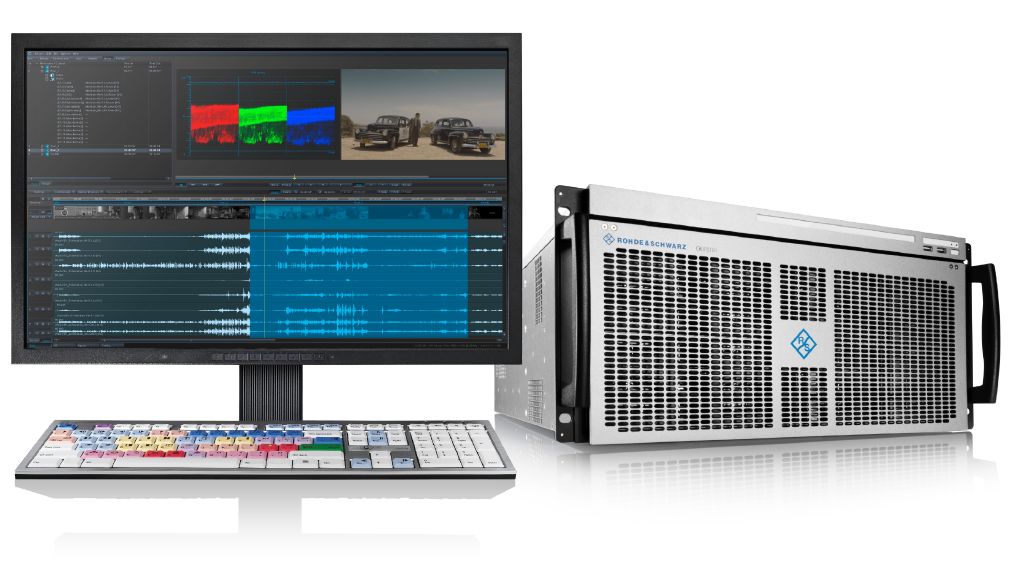IMF mastering with R&S®CLIPSTER
Need: easy exchange of multiple versions of content as one package in a digital format
Solution: interoperable master format (IMF) and R&S®CLIPSTER

Need: easy exchange of multiple versions of content as one package in a digital format
Solution: interoperable master format (IMF) and R&S®CLIPSTER
The current situation in the film industry with its tremendous amount of file formats, codecs and containers to handle digital video data is a real challenge when it comes to exchanging content. This scenario is caused by the lack of a general standard for the exchange of digital video data (similar to the HDCAM SR standard). In addition, there is no proper solution available for easy distribution and transfer of a multitude of master versions (including different languages, subtitles and video inserts) between business partners. To fill this gap, the interoperable master format (IMF) was created by the Society of Motion Picture and Television Engineer (SMPTE) members, including Rohde & Schwarz and 186 well-known leading US studios, manufacturers and vendors.
IMF is an SMPTE standard (SMPTE ST2067 group) based on the digital cinema standards. It is the upcoming solution that will clarify the confusion caused by the multitude of versions, and it will become the file based successor for the tape based solution. The key feature of IMF is its highly flexible versioning capabilities. Versioning minimizes the amount of storage by saving the disparities instead of creating additional flattened versions. Mezzanine level compression allows further size reduction. IMF is the contribution format aimed at business-to-business users such as content owners, distributors, post production facilities and broadcasters.
Content owners can distribute and deliver produced content by using the versioning capabilities to easily create multiple versions as one IMF package (IMP). Distributors, on the other hand, are able to create multiple end formats from such an IMP, e.g. Netflix, Blu-ray™, DVD or mobile phone to name a few. Broadcasters receiving IMPs with program content, commercials or episodes can easily convert the content to their in-house format.
The structure of an IMP is similar to the setup of a digital cinema package (DCP). The IMP contains an output profile list (OPL), one or more composition play lists (CPL), an asset map and a packing list.
The track files are wrapped into an AS-02 subset. The OPL provides a table of contents and transcoding instructions such as data rate, resolution, codec and bit rate. The CPL is comparable to an edit decision list (EDL) or cut list. It includes the information to assemble the playback for the given content and refers to various track files. The asset map is a list of all files in the IMP. The packing list specifies the hash value of all files in the composition and is used to verify if data has been corrupted or tampered with in some way. Within the core framework of IMF, which is responsible for playlists and major constraints such as AS-02 wrapping, audio routing, subtitle parameters, etc., a modular application layer system is available. These layers are aimed at creating plug-in like applications that fulfill requirements such as a higher compressed codec, specific resolutions or frame rates.
When it comes to versioning your master, IMF will help improve your workflow. With R&S®CLIPSTER, the acquired speed reaches another level: the mastering station fully supports the standard (incl. application layer 2 extensions), already supporting IMF at 4K.
Since IMF stores differences between versions instead of creating flattened versions, a minimum of data has to be handled. A common master consists of a main title, main video, main credits and its main audio. A typical version would contain new audio and several video inserts. Due to versioning, different lengths resulting from censorship versions, director’s cut, commercial black insertions/removals, airline edits and modifications are all easily attainable.
R&S®CLIPSTER enables IMF versioning and inventory management of content for use in multi-version, multilingual and multi-delivery media environments. Use R&S®CLIPSTER to create the required IMF with the respective tracks for file based workflows and file based libraries. Ideally, R&S®CLIPSTER is used for B2B exchange and is now available in resolutions of up to 4K instead of the originally planned HD.
R&S®CLIPSTER allows a smooth transition from tape based workflows to digital file based workflows. Using simple object access protocol (SOAP), automate R&S®CLIPSTER to create your IMF mezzanine files as output deliverables.
The highly customized and intuitive Rohde & Schwarz wizards and tools guide you through every step of the mezzanine workflows, simplifying the respective processes.
For high frame rates and 4K applications, R&S®CLIPSTER offers faster than realtime encoding of JPEGE2000 RGB/YUV file sequences up to 500 Mbit/s and beyond, depending on the JPEG2000 profile.
Several integrated optimizing tools allow unique actions: the master and the different IMP versions can be merged, resulting in one single IMP with multiple CPLs. The integrated merge tool allows you to merge, send and archive the individual IMPs created through versioning as one complex deliverable – a major advantage.
R&S®CLIPSTER offers you diverse options for the IMF: version it, merge it, thin it out and transform it into other formats. High-speed generation of compressed formats for delivery and archiving is also available.
Running the IMF workflow on R&S®CLIPSTER gives you a choice. You can flexibly decide to choose either AS-02, AS-1 or IMF – and even switch between them. Whatever your workflow requires at any given time, you can select any option:

